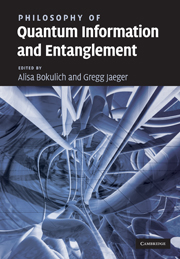Book contents
- Frontmatter
- Contents
- List of contributors
- Preface
- Introduction
- Part I Quantum entanglement and non-locality
- 1 Non-locality beyond quantum mechanics
- 2 Entanglement and subsystems, entanglement beyond subsystems, and all that
- 3 Formalism locality in quantum theory and quantum gravity
- Part II Quantum probability
- Part III Quantum information
- Part IV Quantum communication and computing
- Index
2 - Entanglement and subsystems, entanglement beyond subsystems, and all that
from Part I - Quantum entanglement and non-locality
Published online by Cambridge University Press: 04 August 2010
- Frontmatter
- Contents
- List of contributors
- Preface
- Introduction
- Part I Quantum entanglement and non-locality
- 1 Non-locality beyond quantum mechanics
- 2 Entanglement and subsystems, entanglement beyond subsystems, and all that
- 3 Formalism locality in quantum theory and quantum gravity
- Part II Quantum probability
- Part III Quantum information
- Part IV Quantum communication and computing
- Index
Summary
Introduction
The first realization that the validity of the quantum superposition principle in the Hilbert space describing a composite quantum system may give rise to fundamentally new correlations between the constituent subsystems came in the landmark 1935 paper by Einstein, Podolsky, and Rosen (EPR), where it was shown how the measurement statistics of observables in certain quantum states could not be reproduced by assigning definite wavefunctions to individual subsystems. It was in response to the EPR paper that Schrödinger, in the same year, coined the term entanglement (Verschränkung) to acknowledge the failure of classical intuition in describing the relationship between the “parts” and the “whole” in the quantum world:
Whenever one has a complete expectation catalog – a maximum total knowledge – a ψ function – for two completely separated bodies, …then one obviously has it also for the two bodies together. But the converse is not true. The best possible knowledge of a total system does not necessarily include total knowledge of all its parts, not even when these are fully separated from each other and at the moment are not influencing each other at all.
While Bell's strengthening of the original EPR-paradox setting and the subsequent experimental verification of Bell inequalities irreversibly changed the perception of entanglement from a property of counterintuitive “spookiness” to (beyond reasonable doubt) an experimental reality, the concept and implications of entanglement continue to be associated with a host of physical, mathematical, and philosophical challenges. In particular, investigation of entanglement in both its qualitative and quantitative aspects has intensified under the impetus of quantum information science (QIS).
Information
- Type
- Chapter
- Information
- Philosophy of Quantum Information and Entanglement , pp. 16 - 43Publisher: Cambridge University PressPrint publication year: 2010
Accessibility standard: Unknown
Why this information is here
This section outlines the accessibility features of this content - including support for screen readers, full keyboard navigation and high-contrast display options. This may not be relevant for you.Accessibility Information
- 10
- Cited by
